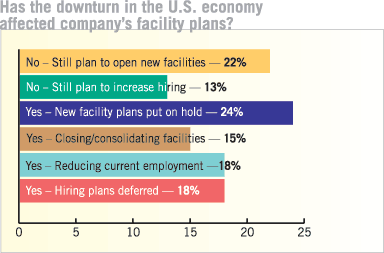23rd Annual Corporate Survey Analysis by Andy Mace
Dec/Jan 09

A Note on the Respondents
The survey participants are predominantly focused on industrial facilities: 64 percent are engaged in manufacturing operations of some form and 14 percent are involved in distribution activities. It is thus not surprising that the overall ranking of the top-25 site selection factors is highly aligned with the location priorities voiced by our manufacturing and distribution-center clients. They are continuously focused on costs and the availability of labor and energy resources.
The sizes of the respondents' companies (70 percent are below 1,000 employees) and proposed new facilities (headcounts mostly below 100 employees) are lower than many of our clients' sizes and headcounts. This may explain why select survey results are rather surprising to me. Specifically, the low priority respondents assign to rail and port proximity is inconsistent with our clients' projects and business models in recent years. It is logical to expect that smaller facilities be less concerned with bulk and international transport movements and costs.
Uptick in Focus on Costs
Comparison of the 2007 and 2008 combined ratings for site selection factors reveals companies' increasing emphasis on external sources of project funding such as tax exemptions, state and local incentives, training programs, and long-term financing. These shifts reflect the more challenging economic environment and increased competition for corporate funding of facility investments. The data are also consistent with clients' growing preference to assess potential incentives earlier in the site selection process. Incentives still do not drive our industrial projects to one location over another, but they increasingly are part of our clients' return-on-investment assessments.
Apparent Contradictions Regarding Transportation Costs
From my perspective, the survey data present inconsistencies in how companies assess the impacts of location on their transportation costs. It is surprising that two factors with major implications on transportation costs - proximity to major markets and proximity to suppliers - are assigned a lower priority than highway accessibility, which has a lower impact on freight costs. Furthermore, highway accessibility should be assigned a lower priority, given the simplicity with which it is measured and the relative ease of finding sites acceptably close to highways.
Regardless of the relative ranking of the transportation-cost factors to each other, it is likely the importance assigned to these factors (including port and rail proximity) will rise if fuel prices swing higher again and if sustainability and carbon-footprint-reduction initiatives retain the focus of global media, governments, and corporations. At the same time, if the economy downswing continues, respondents' priorities around resource availability may drop as demands for labor, land, and buildings decline.
Project Announcements
Ninth Avenue Foods Plans Longview, Texas, Production Operations
12/06/2025
LayerZero Power Systems Expands Streetsboro, Ohio, Manufacturing Operations
12/06/2025
BioStem Technologies Plans Boca Raton, Florida, Headquarters Operations
12/06/2025
Saronic Technologies Expands St. Mary Parish, Louisiana, Operations
12/05/2025
JGA Space and Defense Expands Huntersville, North Carolina, Operations
12/05/2025
SODECIA-AAPICO Plans Orangeburg, South Carolina, Manufacturing Operations
12/05/2025
Most Read
-
Rethinking Local Governments Through Consolidation and Choice
Q3 2025
-
First Person: Filter King’s Expansion Playbook
Q3 2025
-
Rethinking Auto Site Strategy in the Age of Tariffs and Powertrain Shifts
Q3 2025
-
Lead with Facts, Land the Deal
Q3 2025
-
How Canada Stays Competitive
Q3 2025
-
America’s Aerospace Reboot
Q3 2025
-
The Permit Puzzle and the Path to Groundbreaking
Q3 2025


